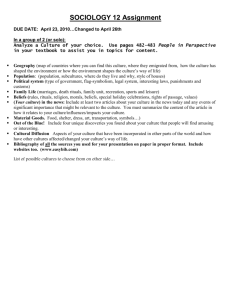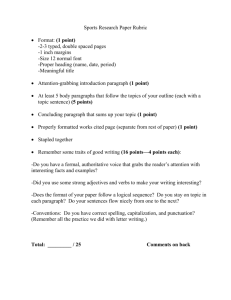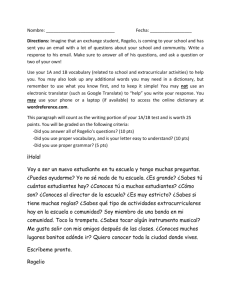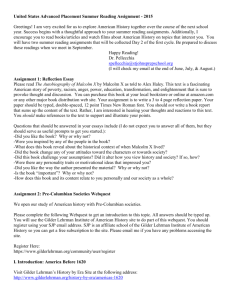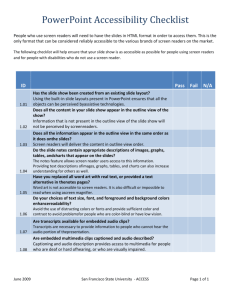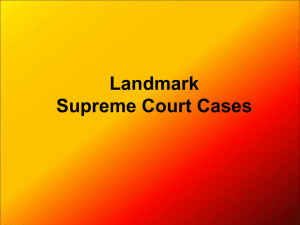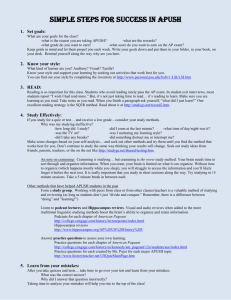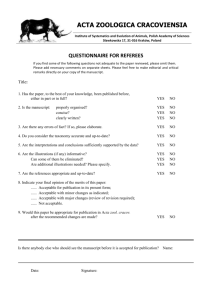written technical reports
advertisement
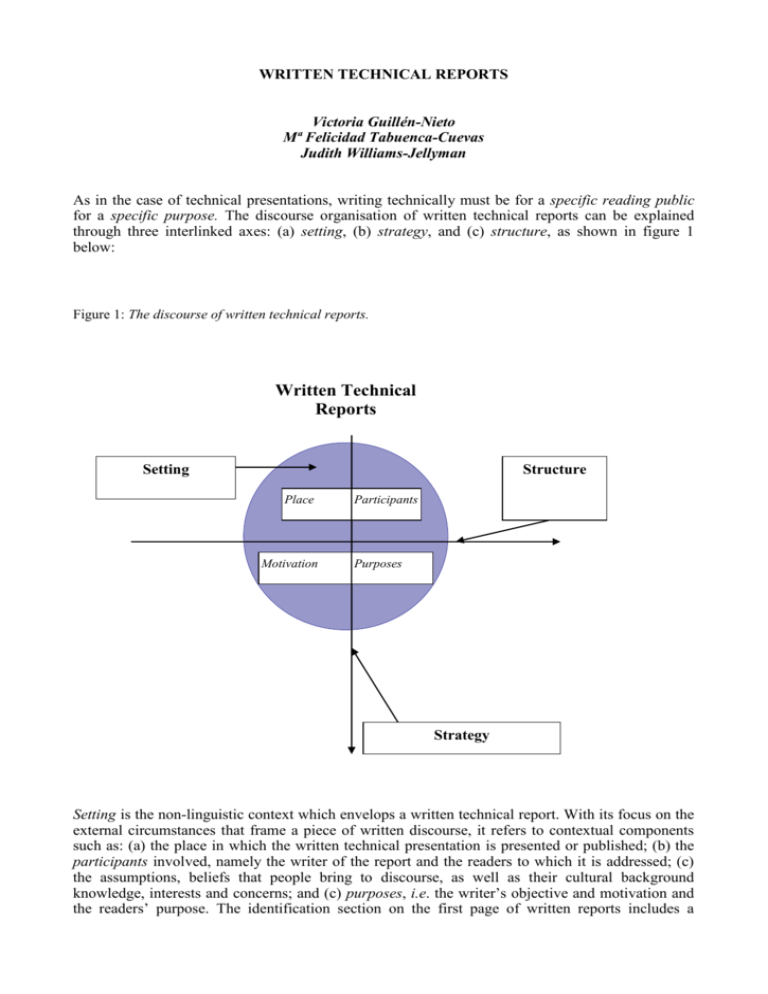
WRITTEN TECHNICAL REPORTS Victoria Guillén-Nieto Mª Felicidad Tabuenca-Cuevas Judith Williams-Jellyman As in the case of technical presentations, writing technically must be for a specific reading public for a specific purpose. The discourse organisation of written technical reports can be explained through three interlinked axes: (a) setting, (b) strategy, and (c) structure, as shown in figure 1 below: Figure 1: The discourse of written technical reports. Written Technical Reports Setting Structure Place Motivation Participants Purposes Strategy Setting is the non-linguistic context which envelops a written technical report. With its focus on the external circumstances that frame a piece of written discourse, it refers to contextual components such as: (a) the place in which the written technical presentation is presented or published; (b) the participants involved, namely the writer of the report and the readers to which it is addressed; (c) the assumptions, beliefs that people bring to discourse, as well as their cultural background knowledge, interests and concerns; and (c) purposes, i.e. the writer’s objective and motivation and the readers’ purpose. The identification section on the first page of written reports includes a number of these contextual elements: (a) the date, (b) the names of all the authors, and (e) the place of origin of the work (institution/department, etc). Strategy is the vertical axis of choice. With its focus on strategy, it foregrounds the tactical nature of written technical reports since it concerns the selection of an appropriate organising principle or dramatic shape to highlight topics, present information and develop arguments. Structure is the horizontal axis of chain. It provides a neat way of conceptualising how discourse units are combined and built up to form the different sections and moves into which written technical reports can be divided. The structural axis accounts for the linear progression of discourse at two levels: (a) the macro-structure which involves the discourse sections into which the written technical report may be divided and (b) the micro-structure which comprises the discourse/rhetorical movements within each section. The three interlinked axes that support the discourse of written technical reports: (a) setting, (b) strategy, and (c) structure are interlinked. For example, the setting is both an important influence on the strategic approach underlying a written technical report and a significant determinant of its discourse structure, as we will see in the sections below. 1. Setting. When planning the content of a written technical report, it is advisable to think about the setting (external circumstances) that might envelop your report: a) The place in which the written technical report may be presented or published, i.e. technical trade journal, professional journal, academic board, engineering conference, an organisation, etc. b) The participants that might be involved, i.e. the writer and the specific reading public. c) The writer’s specific objective and motivation when writing the report. d) The reading public’s specific purpose when reading the report. e) The type of action by the reading public that might be expected, if any. The external variables listed above are also interlinked; for example, who your readers will be depends on where your report will appear. In this respect, an engineering manuscript may take the following forms: a) A paper for a professional journal. b) An article for a technical trade magazine. c) An internal report for your organization. d) A paper for an engineering conference. e) An external report on work done by your organization. f) A thesis for an academic degree. Each publication has a specific readership so you can adapt your report to the interests of each class of readers. Journals usually specify the type of papers they accept for publication, and looking through the journal will give you an idea of the subject matter and technical level of the papers they publish. Trade magazines also give guidelines as to the contents of articles that interest their readers. When there is a call for papers for an engineering conference, a list of the subjects of interest is provided. In the case of company reports, consult with your superiors and colleagues as to the potential readers. Finally a thesis is aimed at your thesis advisor and thesis evaluation committee. Since writing technically must be for a specific reading public for a specific purpose, it is important to think what the reading public is interested in and what they need to know. In other words, you need to bear in mind the intellectual framework in which your potential reading public will be operating. It is essential to find out as much as possible about the potential readers of your written report. So ask yourself: a) Who is the potential reading public of my report? b) What experience and training do they have? c) Why should they be interested in reading a technical report on this subject? d) How will your written technical report benefit them? Knowing the potential reading public will be a critical determinant in choosing the right purpose: a) Informative purpose: the main purpose of many written technical reports is to give the reading public information or facts, for example, to describe a device, process, method or system, to analyse a problem, to develop a theory, etc. b) Instructional purpose: a written technical report can be primarily instructional. Your task might be to instruct new employees to use new equipment or to perform certain routine tasks. c) Persuasive purpose: a written technical report can be primarily persuasive. For example, you might want to convince your reading public to support a particular programme. Once you know your specific audience and specific purpose, you will know what to expect from them: a) Research: the writer’s purpose is to make the audience do some research on the types of information needed for a specific purpose. b) Buy: the writer’s purpose is to make the audience buy a particular working device, system or product. c) Modify: the speaker’s purpose is to promote change in the use or construction of some system or device for a variety of reasons, i.e. efficiency, reliability, safety, etc. In order to match your objectives with the readers' interests you should distinguish between your objectives, i.e. the purpose of the work and your motivations for writing the report. Some objectives may be: a) b) c) d) e) f) To develop a new theory or principle. To apply known principles in practice. To solve an engineering problem in a device, system, etc. To design a new structural form. To develop a new or improved method. To establish a set of standards. Whereas some motivations for writing may be: a) b) c) d) e) f) To become known for your work. To be published in a prestigious journal. To attend a conference and publish your paper in the proceedings. To make an in-company progress report on your engineering project. To describe, for tutorial purposes, certain engineering developments or principles. To satisfy requirements for an academic degree. However, you still need to consolidate the materials into a meaningful message. Much of what your reading public will be able to understand and interpret will depend on how the information is organised and presented. Setting When planning the content of a written technical report, it is advisable to think about the setting (external circumstances) that might envelop your report. Knowing the potential reading public will be a critical determinant in choosing the right purpose. Once you know your specific audience and specific purpose, you will know what to expect from them. In order to match your objectives with the readers' interests you should distinguish between your objectives and your motivations for writing the report. Task: Think about the setting (external circumstances) that might envelop your report and write down your answers to the following questions: a) b) c) d) e) Where will the technical written report be presented or published? Who will be your potential reading public? What is your specific objective and motivation when writing the report? What is the reading public’s specific purpose when reading the report? What type of action might be expected by the reading public? Checklist Rate your planning (3=Excellent; 2=Fairly good; 1=Poor). Did you consider... -the place in which the technical report may be presented or published? -the potential reading public of your technical report? -your objectives and motivations when writing the Yes/No Provide evidence report? -the reading public’s specific objective for reading the report? -the type of action by the reading public that might be expected? 2. Strategy. The selection of the appropriate organisational principle can give a dramatic shape to your technical written report. It is important to select a suitable organising principle that gives appropriate emphasis to your ideas, presents your results in the most advantageous way, and explains why they are important. The work objectives and personal motivations will help you to choose an appropriate dramatic shape for the contents of your report, as shown in table 1 below: Table 1: Matching writer’s objective and motivation with the structure and contents of the technical written report. Objective/motivation To present a theory. Structure/contents Analytic section. Experimental verification section. To describe an application of known principles. Method of application. Advantages and usefulness. Differences/advantages of your design/system. Description of engineering features and their utility. To publish original work in a journal. To write a technical report for use in your organisation. Now that you are clear about your objectives and motivations and have an idea of your readers' interests, you are ready to construct your report strategically. This may be done in the following stages: a) Make a plan. Define the objectives, assess the potential readers and decide on the form your manuscript will take (journal paper, company report, conference paper, etc). b) Orient the reader. Explain the engineering problem or purpose at the beginning, and show how it relates to previous work and current problems. c) Choose the right amount of detail. Too little detail is frustrating, whereas too much is boring and results in the reader not being able to see the wood for the trees. d) Show the overall significance. Explain how your paper fills a need, clarifies a problem, or offers a useful application and why it is important. e) Emphasize the strong points. If your work is new, define how it differs from what is known. Emphasize the main contribution in your paper – the beauty of an engineering design, utility of the results, ingenuity of the method, etc. f) Get peer reviews. Show the draft of your paper to technical experts in your organization to test reader reaction. Don't forget to distinguish between the objectives of written technical report, related to the technical content of your manuscript, and the motivations for writing the paper, which affect how you decide to present the subject to your readers. Some examples are given in table 2 below: Table 2: Matching objectives with requirement for plan. Objectives To design a new structural form. To show practical applications of known principles. To develop a new theory. Requirement for plan Features of conventional structure. Need for improved design. Emphasis on design technique. Review of principles to be applied. Development of the application. Emphasis on utility and practicality. Statement of engineering phenomenon. Proof of how the theory supports the facts. Emphasis on development of the theory to explain the phenomenon. Strategy Matching your objectives and motivation with the structure and contents of the written technical report. Matching objectives with requirement for plan. Task: Plan the strategy (organising principle) that may give a dramatic shape to your technical report. You may wish to follow the stages listed below to define your strategic approach to the content of your written report: a) Match your objectives and motivation with the structure and contents of your written report. b) Match your objectives with a suitable strategic plan to give shape to the contents of your written report. Checklist Rate your strategy (3=Excellent; 2=Fairly good; 1=Poor). Did you... -match your objective and motivation with the structure and content of your report? -make a plan? -match your objectives with requirement for plan? Yes/No Provide evidence 3. Structure. Once you have decided on a strategic approach to presenting the contents in your written report, you still need a structure to link your concepts. 3.1 Plan and organise your report: rough outline. Before writing your technical report, it is advisable to prepare a rough outline taking into account the interests of potential readers and the method of presenting data. An outline shows the intended structure of your paper and where the emphasis lies. Its purpose is to shape the technical information in logical order and also to organise your thinking. The most widely used type is the topic outline which consists of the titles of the main sections, subheadings and sub-subheadings. Another type of outline is the sentence outline which consists of theme sentences for sections and paragraphs. When organising the technical information ask yourself the following questions: a) b) c) d) What are the main ideas? What are the supporting ideas? What details should be included? What is the emphasis on: the data, the method, your recommendations, a new application/design, etc? e) How long should the manuscript be? f) What information should be included in the main illustrations and tables of data? g) What information should be relegated to an appendix? Besides, when writing your general draft it is useful to follow these guidelines: a) Use complete sentences to form coherent paragraphs containing related ideas – preferably one idea per paragraph. b) Separate paragraphs by leaving a line space between them or indenting the first line of each. If a line space is used, indentation may be reserved for presenting lists, formulas, etc. c) Pay special attention to the first sentence of each paragraph (the topic sentence), since this gives the reader a preview of the content and purpose of the paragraph. d) The last sentence of each paragraph is also important, since it should round off the idea in the paragraph and link it to the next paragraph. e) Don't make your paragraphs too long - a typical paragraph would consist of 4-8 sentences. However, paragraphs of only 1 or 2 lines may be used to focus the reader's attention, since they can act as a kind of key sentence. f) Include all the information you wish to transmit in a way that indicates a logical flow of ideas and continuity. Now that you have a rough draft with all the information presented in a clear, logical way, the final step is to perfect the language. Take into consideration the following points: a) Clarity. Express your ideas in a clear, logical way. Put yourself in the position of someone reading your report for the first time and ask yourself questions such as: Does it convey the message you want it to convey? Is it ambiguous in any way? What conclusion might the reader draw? b) Readability. In order to write readable technical reports you may find useful the following grammar guidelines: -Use logical connectives (therefore, with the result that, in order to, etc). -Avoid using very long, complex sentences with multiple clauses. -Use technical terminology consistently, i.e. make sure you use the same technical term for the same concept throughout the written report. - Define your terms, i.e. insert definitions of specialised words the first time they appear. -Don't overdo the use of nouns. -Use verbs for actions or activities: instead of Calculation of the parameters was done, The parameters were calculated. -Use the correct grammatical time frame: something that was but is no longer, e.g. an occurrence, phenomenon over and done with, is expressed in the past/past perfect. A preliminary study was done The patient had been operated on previously -Something that is valid now, e.g. characteristics, relationship, etc., is expressed in the present: linezolid inhibits the growth of microorganisms -Something that began in the past and continues into the present is expressed using the present perfect: This system has been shown to be the most effective. -Avoid vague superlatives: extremely high diffraction efficiency -Use specific figures if possible: a diffraction efficiency of >99% -Avoid redundant words: the very best = the best the most optimal = the optimal -Avoid ambiguities: If you use a relative clause beginning with which and the main clause contains various nouns, make sure it's clear to which noun the relative pronoun refers. c) Conciseness. Conciseness should not be confused with brevity. A concise report says a lot in a few words; a brief report may say little. d) Technical language. Each branch of engineering/science/technology has its own terminology. The author of a formal written report must consider what is appropriate for the readers. Finally, in engineering reports literary style cannot be a substitute for the validity and significance of the technical results. Any new results should be backed up by information in the manuscript. If there are various methods of solving the technical problem, give reasons why you chose the method you did. Interpret your results in a balanced way: nothing is perfect, so mention any negative aspects or limitations of your findings as well, and this will give more credibility to your report. Discussing the significance of your results allows readers to see the implications of your work. In the summary mention any critical factors that affected the outcome of your study, its relation to the prior art, the potential applications of the results and the directions of future developments. Structure Prepare a rough outline taking into account the interests of potential readers and the method of presenting data. Perfect the language. Task: Write a rough outline. Use the following guidelines to organise your ideas: a) b) c) d) What are the main ideas? What are the supporting ideas? What details should be included? What is the emphasis on: the data, the method, your recommendations, a new application/design, etc? e) How long should the manuscript be? f) What information should be included in the main illustrations and tables of data? g) What information should be relegated to an appendix? Checklist Rate the rough outline for your written report (3=Excellent; 2=Fairly good; 1=Poor). Did you... -state your main ideas? Yes/No Provide evidence -specify your supporting ideas? -express what the emphasis is on? 3.2 The layout of the written technical report. The discourse structure of written technical reports consists of the following sections: (a) identification, (b) abstract, (c) table of contents (contents page), (d) introduction, (e) body of the paper, (f) conclusion, (g) recommendations, (h) acknowledgements, and (i) references. We will now look at each of these sections in turn, in further detail. 3.2.1 Identification. The following information should be included on the first page of your report: (a) the date, (b) the title, (c) the names of all the authors, and (d) the place of origin of the work (institution/department, etc). Task: Write the identification section of your written report. Checklist Rate the Identification section of your written report (3=Excellent; 2=Fairly good; 1=Poor). Did you inlude... -the date? -the title? -the names of all the authors? -the place of origin of the work? Yes/No Provide evidence 3.2.2 The abstract. An abstract should describe in a nutshell the main findings and significance of your work. It should only include essential information. Avoid the use of first person constructions (I, we, etc). There are three types of abstracts: a) The indicative type describes the general subject matter of the report in a qualitative way. b) The informative abstract is a condensed version of the engineering work, which highlights the findings but without a discussion or interpretation. c) The informative-indicative abstract is a combination of first two types giving specific information about the main results and general information about the rest of the paper. The type and length of the abstract depends on where your paper will be published (journal, congress proceedings, etc.). A rough guide would be: a) Short communication: 100 words. b) Journal article: 250 words. c) Dissertation: 500 words. However, even a short abstract should include all the relevant information that readers may need. Essential characteristics of an abstract are: (a) completeness, (b) precision, (c) objectivity, (d) clarity, and (e) brevity. For example, an informative or informative-indicative abstract should contain the following rhetorical moves: a) A concise statement of the engineering problem – if possible in a single sentence. b) An explanation of your approach to solving the problem (e.g. analytical method, design technique, device improvement, testing scheme, etc.). c) The principal result (e.g. theoretical or experimental finding, new improved design, recommended course of action, etc.). Think of your abstract as a mini-version of the body of your paper that stands alone and is unambiguous. Do not include figures, tables or literature references. Task: Write the Abstract section of your written report. Checklist Rate the Abstract section of your written report (3=Excellent; 2=Fairly good; 1=Poor). Yes/No Provide evidence -What sort of abstract is it? -How long is it? -Where will it be published? -Would you say it is complete? -Would you say it is precise? -Would you say it is objective? -Would you say it is clear? -Would you say it is brief? 3.2.3 Table of contents (contents page). This is a guide to the internal structure of the document. List all the headings with the corresponding page number: 1. chapter title (first level) 1.1 section heading (second level) 1.2 “ “ 1.2.1 subsection heading (third level) 1.2.2 “ “ 1.2.3 “ “ Avoid using more than three levels of numbering. Task: Write the Table of contents section of your written report. Checklist Rate the Table of contents of your written report (3=Excellent; 2=Fairly good; 1=Poor). Yes/No -Is the division between levels consistent? Provide evidence -Are all headings listed with their corresponding number? -How many levels of numbering did you use? 3.2.4 Introduction. The introduction is independent of the abstract and should be written as though the latter did not exist. It may include the following rhetorical moves: a) b) c) d) e) f) The purpose of the manuscript. A definition of the engineering problem. A brief historical review. A reference to previous work in the same field. The scope of the manuscript. A brief indication of the technical contents to follow. Try to arouse the reader's curiosity by posing one or more specific questions concerning some unexplained phenomena, proposing a methodological approach to solving the problem, etc. Task: Write the Introduction section of your written report. Checklist Rate the Introduction section of your written report (3=Excellent; 2=Fairly good; 1=Poor). Did you... -state the purpose of the text? -define the problem? -provide a brief historical review? -make reference to previous work in the field? -specify the scope of the manuscript? -orient the reader by indicating the technical contents to follow? 3.2.5 Yes/No Provide evidence Body of the paper. The body of the paper may consist of the following rhetorical moves: (a) results and (b) discussion. That should be easily identified by means of clear headings. If there is a Results section it should be limited to a clear account of your findings. Interpretation of your results should be kept for the Discussion section. a) Results The purpose of this section is to describe the most significant findings of your work or study. Results section may be broken down into sub-sections identified by clear and short sub-headings to make it easier for the reader to assimilate the information. When reporting your results use short simple sentences in the past tense and passive voice and avoid the use of the personal pronoun I): No relationship was found between (...) X was seen to increase as Y decreased Whereas interrelated results or those to be compared could be presented in a table, functional relationships are often best illustrated in the form of diagrams or graphs. Likewise, it is not advisable to include too many data. Long lists of results relating to similar experiments could be included in an appendix, and just a summary with one or two examples in Results section. Finally, you may find useful to comment on the reliability of the data you report and mention any limitations or procedural shortcomings that may have affected the outcome of your work. Task: Write the Results section of your written report. Checklist Rate the Results section of your written report (3=Excellent; 2=Fairly good; 1=Poor). Yes/No Provide evidence -Did you describe the most important findings of your report? -Did you divide the Results section into sub-sections? -Were sub-sections clearly indicated by sub-headings? -Did you use the past tense when reporting the results? -Did you use the passive voice when reporting the results? -Were interrelated results presented in a table? -Were functional relationships shown in the form of a diagram or graph? -Did you present long lists of results of similar experiments? -Did you comment on the reliability of your data? -Did you mention any shortcomings that may have affected your findings? b) Discussion The purpose of this section is to interpret your results, relate your findings to the prior art, and evaluate the significance of your work. Any reference to other authors’ results must be accompanied by the appropriate citation. Underline what your work has achieved and relate it to the objectives you established at the outset. In this section you may express your own personal opinion: I therefore consider that (...) In my opinion, the results show (...) and perhaps speculate about what may happen or should be done in the future: Based on our findings, further studies should be done (...) In this section include illustrations, tables, graphs, examples etc. that illustrate your most important points and main contributions (for the use of graphics, see point 4.) Task: Write the Discussions section of your written report. Checklist Rate the Discussion section of your written report (3=Excellent; 2=Fairly good; 1=Poor). Yes/No Provide evidence -Did you relate your findings to the prior art? -Did you evaluate the significance of your work? -Did you relate your achievements to the objectives established at the beginning? -Did you express your personal opinion? -Did you speculate what may happen or should be done in the future? -Did you include any illustrations, tables, graphs, etc? 3.2.6 Concluding. The concluding section may consist of the following moves: (a) summarizing and (b) conclusions a) Summarising. A standard way of concluding a descriptive or tutorial paper (e.g. technical progress report, description of engineering features of a device or system, tutorial on engineering principles) is to summarise the main points. The summary should give more information than does an abstract or introduction, but should be discriminating and clarifying. Unnecessary details should be eliminated and your results brought into their proper perspective. Make your summary brief but strong. b) Conclusions. In the case of research or development reports (e.g. summary project report, original design of device/system, development of process/method), it is much better to end with a conclusions section which not only summarizes but also interprets your results. In this section you can point out what is significant and why your results are valid. You could even mention some negative aspects (e.g. limitations of your study, minor defects and how they can be rectified) to make your paper more convincing, as well as pointing out directions for future work and applications. c) Recommendations section. If your paper concerns an analysis of an engineering problem or existing situation to determine the best course of action (e.g. proposal for engineering project study of existing technical problem, analysis of faulty procedures), a recommendations section is the ideal way to conclude. Your recommendations should be concise, clear-cut, and based on your findings. Avoid qualifying statements. Task: Write the Conclusions section of your written report. Checklist Rate the Conclusions section of your written report (3=Excellent; 2=Fairly good; 1=Poor). Yes/No Provide evidence -Did you point out what is significant? -Did you point out why your results are valid? -Did you mention any negative aspects? -Did you make reference to future directions for future work and applications? -Did you include any recommendations? -Were your recommendations concise and based on your findings? 3.2.7 Acknowledgements. Here you can express gratitude to people and institutions that helped you in your work, e.g your thesis advisor, or institutions that gave you financial backing, etc. 3.2.8 References. List all the sources you consulted when carrying out your study and writing the report. Task: Write the Acknowledgements and References sections of your written report section of your written report. Checklist Rate the Acknowledgements and References sections of your written report (3=Excellent; 2=Fairly good; 1=Poor). Yes/No Provide evidence -Did you include an Acknowledgement section? -Did you include a Reference section? -Were references quoted consistently? -Did you follow the publisher’s guidelines when writing the Reference section? 4. Graphics. When describing or interpreting your main findings, use graphics. These are most effective when they serve one of the following purposes: (a) to describe a function, (b) to show the external appearance, (c) to show internal structures, (d) to illustrate a phenomenon, (e) to demonstrate relationships, (f) to define novelty and originality. On the contrary, it is not advisable to use illustrations in the following cases: (a) the figure has already appeared in the literature, (b) the information in the figure is fully explained in the text, (c) the figure emphasizes a trivial or irrelevant point, (d) the data could be more effectively listed in a table, and (e) the figure confuses more than it clarifies the issue. Similarly, try not to include too much information in a figure. Aim for simplicity and clarity. Place the figure near where you make reference to it in the text. The four basic forms of technical illustrations and their typical uses are as follows: 4.1 Charts. a) Line chart: it indicates the relationship between variables, comparisons, trends, relative changes (If data is to be read from the curve the coordinate scales must be sufficiently precise): Sample Line chart. 200 150 Product 3 100 Product 2 Product 1 50 0 1er 2do 3er 4to trim . trim . trim . trim . b) Surface chart: it shows cumulative totals of data from successive components (suitable when the curves depict gradual changes and do not overlap): Sample Surface chart. 100 50 50-100 0-50 0 Este 1er trim . 3er trim . c) Bar chart: it shows a comparison between fixed sums for successive time intervals (suitable when the differences between the quantities depicted are substantial: Sample Bar chart. 100 80 60 Product 1 40 Product 2 20 Product 3 0 1er 2do 3er 4to trim . trim . trim . trim . d) Pie chart: it shows relative proportions of the parts of a process or object (suitable for portraying percentages of a whole process but not a large number of small percentages): Sample Pie chart. 1er trim . 2do trim . 3er trim . 4to trim . e) Flow chart: it shows steps in a process. 4.2 Drawings. These are pictorial representation of physical objects, details, cross-sections, etc. and are suitable for illustrating details that would not appear in a photograph and to emphasis important pictorial features). 4.3 Diagrams. These are abstractions, symbolic configurations, operating principles. 4.4 Photographs. These are realistic views of objects in perspective. 4.5 Tables. Presenting data in the form of tables is another way of clarifying or emphasising information and again they should be placed near where they are mentioned in the text. Don't make the table too complex or overcrowd it with unnecessary information. Keep it brief and is easy to understand at a glance. It should support your text and highlight some of the pertinent points. Tables may also be used to compile reference data. In this case they may be quite long and are best omitted from the body of the paper and included in an appendix. Tables have the advantage of saving space and make it easier to appreciate trends and comparisons. Also the numerical data in tables are much more precise and easier to use for calculations than those presented in the form of line charts. However, only use tables if they make the text more understandable and the data are not already in the text. 4.5.1 Structural elements of a Table. The main elements of a formal table are: a) The Title: this includes the table number together with a concise description of purpose and content, e.g. Table 1. Levofloxacin MIC of strains studied. b) The Boxhead: this contains the vertical column headings and sub-headings. These are usually the dependent variables (temperature, velocity, performance, cost, etc.). c) The Stub: this contains the horizontal line headings. These are the independent variables (e.g. materials, processes, objects, etc. being measured). d) The Field: this contains the tabulations of data. e) The Footnotes: these provide explanatory comments (e.g. the meanings of any abbreviations used in the table). Sample Table Stub Stub Stub Stub Title Boxhead Field Field Field Field Boxhead Field Field Field Field Boxhead Field Field Field Field Footnote: When the purpose of the table is to compare data, it is usually better to arrange them in columns rather than in rows, since vertical comparisons are easier to read. Apart from tables of supplementary data, other types of information that could be included in an appendix would be: the derivation of mathematical equations, description of equipment or procedures, analyses supporting your main findings, etc. Task: Design your own graphs for describing or interpreting the main findings of your work. Checklist Rate the technical illustrations you have included in your written report (3=Excellent; 2=Fairly good; 1=Poor). Yes/No -What sort of technical illustrations have you used? -Did you use any technical illustration to describe a function? -Did you include any technical illustration to show external appearance? -Did you make use of any technical illustrations to show internal structures? -Did you use any technical illustrations to illustrate a phenomenon? -Did you include any technical illustrations to demonstrate relationships? -Did you use any technical illustrations to define novelty and originality? -Do you think your technical illustrations provide simple and clear information? -Do you think technical figures are placed near where you make reference to them in the Provide evidence text? Structure The discourse structure of written technical reports consists of the following sections and rhetorical moves: a) Identification. b) Abstract. c) Table of contents (contents page). d) Introduction. e) Body of the paper: (a) Results and (b) Discussion. f) Conclusion: (a) Summary, (b) Conclusions, (c) Recommendations. g) Acknowledgements. h) References.
